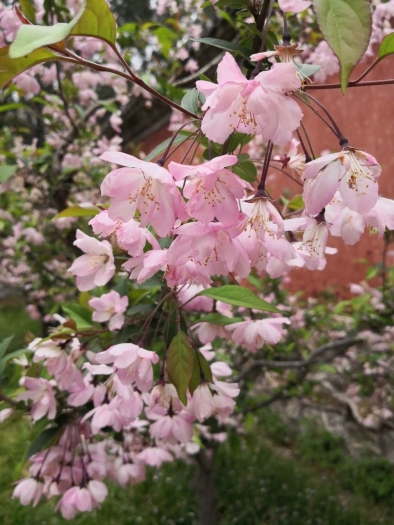Hall Crabapple
(Sinomalus halliana)
Hall Crabapple (Sinomalus halliana)
/
/

Dieter Albrecht
CC BY-SA 4.0
Image By:
Dieter Albrecht
Recorded By:
Copyright:
CC BY-SA 4.0
Copyright Notice:
Photo by: Dieter Albrecht | License Type: CC BY-SA 4.0 | License URL: https://creativecommons.org/licenses/by-sa/4.0/ | Attribution: Dieter Albrecht (cc-by-sa) | Rights Holder: Dieter Albrecht | Publisher: PlantNet | Date Created: 2018-04-19T13:49:25Z | Title: Malus halliana Koehne: flower | Notes: |




Estimated Native Range
Summary
Sinomalus halliana, commonly known as Hall Crabapple, is a deciduous shrub or small tree native to the mixed forests and forest edges of North-Central and Southeastern China. It typically grows up to 5 meters (17 feet) tall and wide, with a rounded form that provides visual interest throughout the year. The Hall Crabapple is particularly noted for its showy, fragrant pink flowers that bloom in spring, followed by small, purple fruits that can attract birds and wildlife. The bark is gray and may become slightly scaly with age, adding to its winter appeal.
Hall Crabapple is valued in cultivation for its beautiful spring blossoms and its relatively small size, which makes it suitable for urban gardens and residential landscapes. It can be used as a specimen plant, in mixed borders, or as part of a wildlife garden. This species is adaptable to a range of soil types, provided they are well-drained, and it thrives in full sun to partial shade. While generally easy to maintain, it can be susceptible to common crabapple diseases such as apple scab and fire blight. Pruning may be necessary to maintain its shape and to remove any diseased or damaged wood. Gardeners should be aware that, like many crabapples, it can self-seed and may require management to prevent unwanted spread.CC BY-SA 4.0
Hall Crabapple is valued in cultivation for its beautiful spring blossoms and its relatively small size, which makes it suitable for urban gardens and residential landscapes. It can be used as a specimen plant, in mixed borders, or as part of a wildlife garden. This species is adaptable to a range of soil types, provided they are well-drained, and it thrives in full sun to partial shade. While generally easy to maintain, it can be susceptible to common crabapple diseases such as apple scab and fire blight. Pruning may be necessary to maintain its shape and to remove any diseased or damaged wood. Gardeners should be aware that, like many crabapples, it can self-seed and may require management to prevent unwanted spread.CC BY-SA 4.0
Plant Description
- Plant Type: Shrub, Tree
- Height: 13-17 feet
- Width: 8-12 feet
- Growth Rate: Moderate
- Flower Color: Pink
- Flowering Season: Summer, Fall
- Leaf Retention: Deciduous
Growth Requirements
- Sun: Full Sun
- Water: Medium
- Drainage: Slow, Medium, Fast
Common Uses
Bee Garden, Bird Garden, Butterfly Garden, Hummingbird Garden, Showy Flowers
Natural Habitat
Mixed forests and forest edges
Other Names
Common Names: Hall Crab Apple
Scientific Names: , Malus halliana, Sinomalus halliana, Malus halliana f. parkmannii, Malus halliana var. spontanea, Pyrus halliana, Malus domestica var. halliana, Malus floribunda var. parkmanni, Malus parkmanni, Pyrus halleana
GBIF Accepted Name: Sinomalus halliana (Koehne) Rushforth